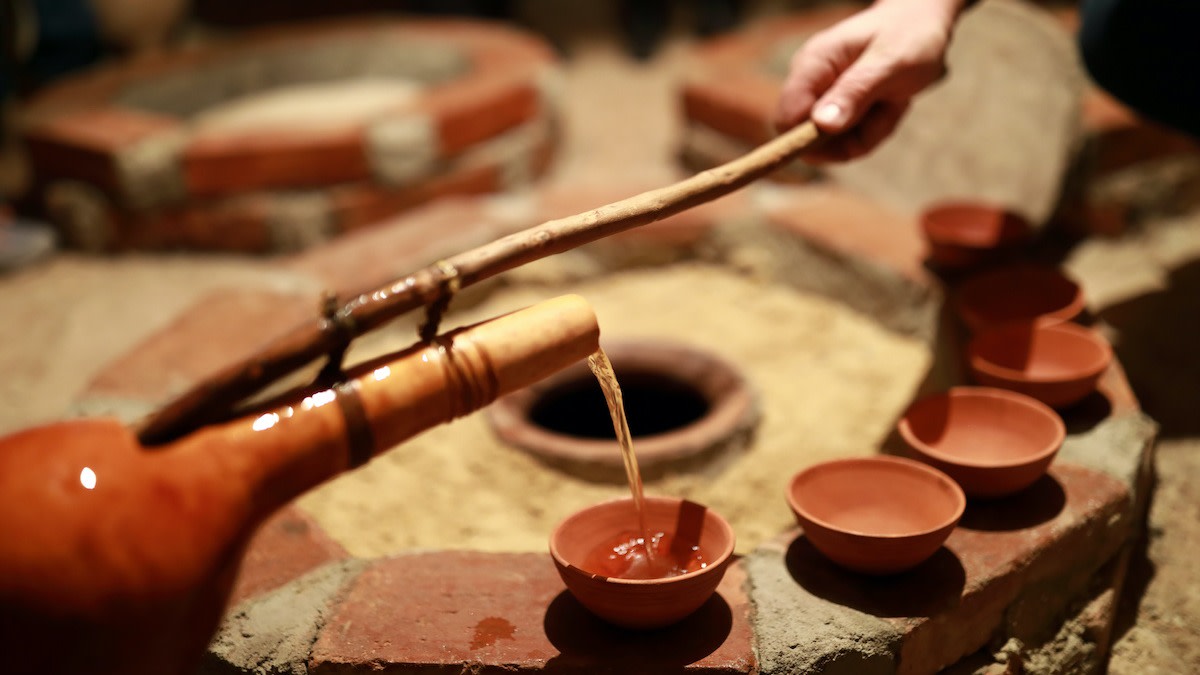Guide to Qvevri Wine: Learn About Traditional Georgian Wine
Written by MasterClass
Last updated: Jun 7, 2021 • 3 min read
Learn more about the large earthenware vessels called qvevri and the ancient winemaking method associated with them.
Learn From the Best
What Are Qvevri?
Qvevri (also spelled kvevri) are Georgian egg-shaped clay vessels designed to be buried underground. Georgian qvevri are similar to Spanish tinajas and Roman amphorae, but qvevri are the only storage vessels meant to be buried. Thousands of years ago, Georgian qvevri were used to store everything from grains to cheese, and they ranged in size from 13 gallons (for home use) to 1,000 gallons (for commercial production). Nowadays, qvevri aren’t widely used for food storage, but they are still an important part of traditional Georgian winemaking. In fact, qvevri winemaking has spread outside Georgia to winemaking regions in Italy, Slovenia, Austria, the United States, and more.
What Is the History of Qvevri Winemaking?
Georgia, along with Armenia, is one of the world’s oldest wine-producing regions, since residual evidence of winemaking was found on fragments of 8,000-year-old qvevri. Although commercial-size qvevri have been found, for thousands of years winemaking in Georgia took place in the home, with families filling up their personal qvevri with hand-picked indigenous grapes. Under Soviet rule (1921–1991), indigenous grape varietals were uprooted and small-batch producers were replaced by large-scale industrial wine production. Families still preserved the techniques of traditional qvevri wine in the home. In the early 2000s, winemakers inspired by Georgian wine culture began to spread qvevri winemaking techniques along with a taste for Georgian-style amber wines. In 2013, UNESCO added the qvevri winemaking process to its List of the Intangible Cultural Heritage of Humanity.
How Are Qvevri Wines Made?
In general, qvevri wines are made according to the following process:
- Maceration: Traditional Georgian winemaking traditions involve crushing grapes and placing the grape juice, along with the grape skins, stems, and pips (collectively known as chacha), into clean qvevri lined with beeswax for fermentation.
- Alcoholic and malolactic fermentation: After an initial maceration period, the mixture undergoes both alcoholic fermentation (starch is converted to alcohol) and malolactic fermentation (malic acid is converted into lactic acid and carbon dioxide). Alcoholic fermentation produces the alcohol, while the malolactic fermentation process decreases acidity, adds flavor, and stabilizes wine.
- Aging and decanting: Once both fermentation processes are complete, the qvevri are covered with lids and sealed with clay or beeswax. After about six months, the wine is decanted for bottling. (Or in the case of some red wines, placed in a different, clean qvevri for continued aging.) Due to the qvevri’s egg shape, the chacha collects in the bottom of the vessel, making the decanting process easier. The leftover chacha is distilled into a liquor called, appropriately, chacha.
The exact process varies regionally: In the Kakheti region where almost 75 percent of Georgian wine is produced, its famous amber wines are made from white grapes that ferment with the chacha for several months. In the Imereti region, a smaller amount of skins (and no stems) are used, for a lighter white wine flavor.
The marani, or wine cellar, also affects production: In warmer climates like Kakheti, qvevri are buried in underground marani; whereas in cooler regions, like Imereti, the marani might take the form of outdoor sheds where qvevri are only partially buried.
What Do Qvevri Wines Taste Like?
The flavor of Georgian qvevri wine depends on a variety of factors including grape varieties and the length of fermentation. Wine producers like to use qvevri for the tannic quality and complex, mineral flavor they add to wines. Winemakers say that wines fermented in qvevri develop more personality earlier in the fermentation process.
When fermented with the chacha, white wines made with grapes such as the ancient Georgian varieties rkatsiteli are known as skin-contact or orange wines. They have more tannins than white wines made by separating the grape juice from the chacha before fermentation. The most popular Georgian red varietal, saperavi, it typically produced as either a sweet wine or a dry red wine aged for about three years.
Outside of Georgia, winemakers use qvevri to produce wines with their local grapes, such as syrah, ribolla, and cabernet sauvignon.
Want to Learn More About Wine?
Want to learn more about the culinary arts? The MasterClass Annual Membership provides exclusive video lessons from master chefs and wine critics, including James Suckling, Chef Thomas Keller, Gordon Ramsay, Massimo Bottura, and more.
